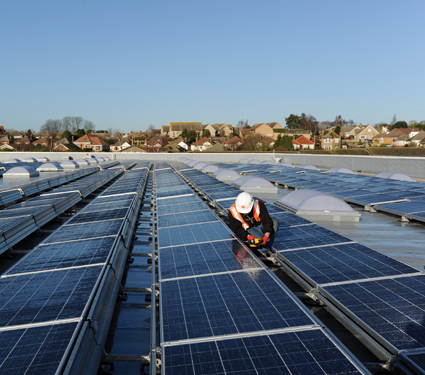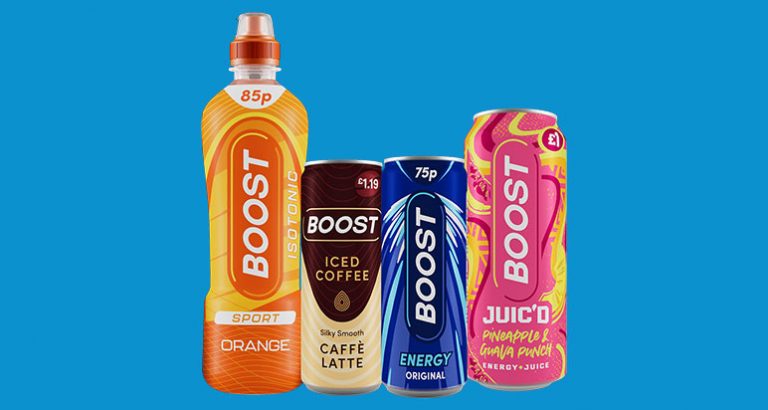As retailers looks at new ways to save money, renewable energy sources are becoming a more attractive proposition, with convenience stores perfectly equipped to save, and actually earn cash, by installing solar panels on their store roofs.
by Kevin Scott
Once a fad, environmental awareness is now simply part of the world in which we all operate. While most retailers have always been keen to help protect the planet, the business case for doing so hasn’t always stacked up. One instance, however, where there is a strong financial argument for upping your environmental credentials as a retailer is in the adoption of Solar Photovoltaics, or Solar PVs as they’re more commonly known. You will no doubt have seen more and more of these panels appearing on domestic and commercial property roofs over the last couple of years.
This surge in interest in Solar PVs has been driven by the increasing price of energy and better awareness of the financial benefits of being more energy efficient – so would it make sense for your store?
Firstly, it will help to understand how Solar PVs actually work. These panels are the most popular type of what is known as renewable energy (others include Biomass fuel, Ground Source Heat Pumps, Air Source Heat Pumps and Solar Thermal). In a nutshell, Solar PVs capture light using special cells and the energy in this light is then converted to electricity. Note that they don’t need direct sunlight to work, just daylight, and electricity can be generated in grey skies so they do work in Scotland.
Critical to the viability of the scheme is the Feed-in-Tariff (FiT), a Government scheme where energy providers actually pay those with Solar PVs for every kilo-watt hour (kWh) of electricity generated.
To work out how much money you could save, a simple method is to consider that a single solar panel generates around 250 watts of energy. So, if the typical c-store has room for 14 panels on its roof that would be a system capable of generating 3.5 kilo-watts. A system of this size can generate around 3,000kWh of electricity – which, in English, means around 75% of the electricity you would use in your home in a year. Obviously a store uses far more electricity but the potential is clear.
Be aware, however, that installing such a system is not cheap. Our example system of 3.5kWh will set you back around £7,500 (including 5% VAT). However, Solar PV experts Renewable Resources (Energy Solutions) estimate that a 10-12% return on investment annually is typical for its commercial customers.
Feed-in-tariff
After the launch of the Feed-in-Tariff in 2010, it became evident to the Government that if installations kept growing at the rate they were, it would soon become too costly. The scheme was becoming a victim of its own success and so in November 2011 a cut in the rates was announced. Not surprisingly, this led to a downturn in the number of installations as, without the Government funding, the number of years required to recoup the cost of the installation increased significantly. That said, by entering into a FiT agreement with the Government, you are still being guaranteed payment for 20 years.
Paul Gribben, Chief Executive and founder of the Scottish-born Renewable Resources (Energy Solutions), says that for commercial businesses, Solar PVs remains hugely attractive.
“More and more businesses are looking for solutions to lower carbon emissions, improve long-term energy security, achieve energy autonomy, and ultimately reduce electricity costs,” he says. “To be viable, the solution must also offer a sound return on investment and as the Solar PV market matures and the technology advances, module prices and installation costs are continually decreasing and producing good overall yields.”
Due to economies of scale in solar PV manufacturing and increased cell efficiency, the pricing of solar modules is now half what it was in 2010, and these prices will continue to drop as is the case with any technology. Unfortunately, the Feed-in-Tariff has also been recalculated downwards to reflect this. Gribben explains that this doesn’t mean the end of a good deal though: “In August 2012, a very clear degression scheme (where tariffs are progressively reduced to reflect the lower costs of installation as technology advances) was introduced by the Department of Energy and Climate Change to bring long-term stability and predictability to the industry. This means that if the installation level is intense, the degression will be higher; if it is low, the degression will be lower as well. In addition, the FiT rates will continue to be linked with the Retail Price Index so they will increase or decrease with inflation.”
In short, the sooner you install a system, the more it will cost but the higher the FiT you’ll receive.
One retailer that has installed Solar PVs is Giacopazzi’s. The Milnathort retailer has around 40 panels stored on its roof, which pays for two and month’s of the shop’s electricity every year. Managing Director Joanna Giacopazzi installed the panels just over a year ago – and just before the Feed-in-tariff dropped. “There was a personal reason for doing it,” she says. “My dad had retired from the shop and had started a solar energy business, so we thought, why not put them on the shop roof. At the time the tariff was hugely appealing. No one was earning money from their savings and I said that instead of putting money under their mattress people should put it on their roof. That’s maybe changed now with the drop in the tariff, but we’ve got a good deal.”
Joanna has worked out that the system, which cost £20,000 even with family-friendly prices, will pay for itself within four years, and from there on in, the savings will be huge.
“It makes so much sense. With the amount of electricity a shop uses – with lights and chillers operating from 5am until 10pm, it makes so much sense to generate our own electricity.”
Joanna says there are literally no downsides to the system although she’s quick to point out that any retailers looking to install PVs should shop around. “I’ve heard stories of domestic customers getting ridiculous quotes but not knowing they’re ridiculous because they don’t have any frame of reference,” she says.
Joanna also points out another positive aspect of a PV system: “It also shows how responsible you can be as a retailer from an environmental point of view.”
This is something that Gribben is also quick to point out. He says: “Solar PV is an ideal tool to reduce carbon footprint and electricity costs and provide energy security, while also ensuring strong financial returns. It’s an easy option for any business looking for a less expensive and greener energy source and I have no doubt the market will continue to grow in the future.”
A word of warning though – in order to take advantage of the Feed-in-tariff, the system must be installed by a Microgeneration Certification Scheme (MCS) accredited fitter.
A list of local companies will be available on the internet, but should you required any further information, just get in touch with us here at SLR and we’ll do what we can to point you in the right direction.
Solar PVs – the pros and cons
Pros
- The Feed-in-tariff pays you a set rate per kWh of electricity generated, while any electricity exported back to the grid provides an additional rate
- The Feed-in-tariff is guaranteed for 20 years
- Even Scotland’s seemingly endless grey skies allow electricity to be generated as electricity is produced by light, not just direct sunlight
- You’ll be doing your bit for the environment by producing clean energy
- You are protecting yourself against rises in electricity costs.
Cons
- Beware of what way your roof faces – if you don’t face to the south by some degree, you’ll generate less electricity and ‘payback’ time will be longer
- Panels don’t last forever and so there will be maintenance costs
- Panels will also need cleaned to ensure they are optimally efficient
- If you plan on selling your store, potential owners may be put off.
The Feed-in-Tariff
There are three financial benefits to the FiT:
1 A generation tariff payment, which is based on the total electricity generated and the energy type
2 An export tariff payment, which is for any energy exports made when generating more electricity than you use
3 Lower bills from your supplier for the electricity you use that is supplied by them.






